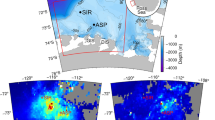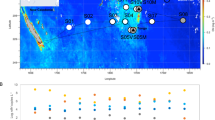Abstract
Oceanic dissolved organic carbon (DOC) is an important carbon pool, similar in magnitude to atmospheric CO2, but the fate of its oldest forms is not well understood1,2. Hot hydrothermal circulation may facilitate the degradation of otherwise un-reactive dissolved organic matter, playing an important role in the long-term global carbon cycle. The oldest, most recalcitrant forms of DOC, which make up most of oceanic DOC, can be recovered by solid-phase extraction. Here we present measurements of solid-phase extractable DOC from samples collected between 2009 and 2013 at seven vent sites in the Atlantic, Pacific and Southern oceans, along with magnesium concentrations, a conservative tracer of water circulation through hydrothermal systems. We find that magnesium and solid-phase extractable DOC concentrations are correlated, suggesting that solid-phase extractable DOC is almost entirely lost from solution through mineralization or deposition during circulation through hydrothermal vents with fluid temperatures of 212–401 °C. In laboratory experiments, where we heated samples to 380 °C for four days, we found a similar removal efficiency. We conclude that thermal degradation alone can account for the loss of solid-phase extractable DOC in natural hydrothermal systems, and that its maximum lifetime is constrained by the timescale of hydrothermal cycling, at about 40 million years3.
This is a preview of subscription content, access via your institution
Access options
Subscribe to this journal
Receive 12 print issues and online access
$259.00 per year
only $21.58 per issue
Buy this article
- Purchase on Springer Link
- Instant access to full article PDF
Prices may be subject to local taxes which are calculated during checkout



Similar content being viewed by others
References
Dittmar, T. & Stubbins, A. Dissolved Organic Matter in Aquatic Systems Vol. 12 (Elsevier, 2014).
Hansell, D. A. Recalcitrant dissolved organic carbon fractions. Ann. Rev. Mar. Sci. 5, 421–445 (2013).
Elderfield, H. & Schultz, A. Mid-ocean ridge hydrothermal fluxes and the chemical composition of the ocean. Annu. Rev. Earth Planet. Sci. 24, 191–224 (1996).
Jiao, N. et al. Microbial production of recalcitrant dissolved organic matter: Long-term carbon storage in the global ocean. Nature Rev. Microbiol. 8, 593–599 (2010).
Loh, A. N., Bauer, J. E. & Druffel, E. R. M. Variable ageing and storage of dissolved organic components in the open ocean. Nature 430, 877–881 (2004).
Flerus, R. et al. A molecular perspective on the ageing of marine dissolved organic matter. Biogeosciences 9, 1935–1955 (2012).
Lang, S. Q., Butterfield, D. A., Lilley, M. D., Paul Johnson, H. & Hedges, J. I. Dissolved organic carbon in ridge-axis and ridge-flank hydrothermal systems. Geochim. Cosmochim. Acta 70, 3830–3842 (2006).
McCarthy, M. D. et al. Chemosynthetic origin of 14C-depleted dissolved organic matter in a ridge-flank hydrothermal system. Nature Geosci. 4, 32–36 (2011).
Santelli, C. M. et al. Abundance and diversity of microbial life in ocean crust. Nature 453, 653–656 (2008).
Siskin, M. & Katritzky, A. R. Reactivity of organic compounds in hot water: Geochemical and technological implications. Science 254, 231–255 (1991).
McCollom, T. M. & Seewald, J. S. Experimental study of the hydrothermal reactivity of organic acids and acid anions: II. Acetic acid, acetate, and valeric acid. Geochim. Cosmochim. Acta 67, 3645–3664 (2003).
Yamanaka, T. et al. Shallow submarine hydrothermal activity with significant contribution of magmatic water producing talc chimneys in the Wakamiko Crater of Kagoshima Bay, southern Kyushu, Japan. J. Volcanol. Geotherm. Res. 258, 74–84 (2013).
Lang, S. Q., Butterfield, D. A., Schulte, M., Kelley, D. S. & Lilley, M. D. Elevated concentrations of formate, acetate and dissolved organic carbon found at the Lost City hydrothermal field. Geochim. Cosmochim. Acta 74, 941–952 (2010).
Brault, M. & Simoneit, B. R. T. Trace petroliferous organic matter associated with hydrothermal minerals from the Mid-Atlantic Ridge at the Trans-Atlantic. J. Geophys. Res. 94, 9791–9798 (1989).
Seewald, J. S., Seyfried, W. E. & Thornton, E. C. Organic-rich sediment alteration: An experimental and theoretical study at elevated temperatures and pressures. Appl. Geochem. 5, 193–209 (1990).
Wellsbury, P. et al. Deep marine biosphere fuelled by increasing organic matter availability during burial and heating. Nature 388, 573–576 (1997).
Wankel, S. D. et al. Influence of subsurface biosphere on geochemical fluxes from diffuse hydrothermal fluids. Nature Geosci. 4, 461–468 (2011).
Shock, E. L. & Schulte, M. D. Organic synthesis during fluid mixing in hydrothermal systems. J. Geophys. Res. 103, 28513–28527 (1998).
McCollom, T. M. & Seewald, J. S. Abiotic synthesis of organic compounds in deep-sea hydrothermal environments. Chem. Rev. 107, 382–401 (2007).
McDermott, J. M. Pathways for abiotic organic synthesis at submarine hydrothermal fields. Proc. Natl Acad. Sci. USA 112, 7668–7672 (2015).
Reeves, E. P., McDermott, J. M. & Seewald, J. S. The origin of methanethiol in midocean ridge hydrothermal fluids. Proc. Natl Acad. Sci. USA 111, 5474–5479 (2014).
Klevenz, V., Sumoondur, A., Ostertag-Henning, C. & Koschinsky, A. Concentrations and distributions of dissolved amino acids in fluids from Mid-Atlantic Ridge hydrothermal vents. Geochem. J. 44, 387–397 (2010).
Fuchida, S., Mizuno, Y., Masuda, H., Toki, T. & Makita, H. Concentrations and distributions of amino acids in black and white smoker fluids at temperatures over 200 °C. Org. Geochem. 66, 98–106 (2014).
Kadko, D. & Butterfield, D. A. The relationship of hydrothermal fluid composition and crustal residence time to maturity of vent fields on the Juan de Fuca Ridge. Geochim. Cosmochim. Acta 62, 1521–1533 (1998).
Fontaine, F. J., Wilcock, W. S. D., Foustoukos, D. E. & Butterfield, D. A. A Si-Cl geothermobarometer for the reaction zone of high-temperature, basaltic-hosted mid-ocean ridge hydrothermal systems. Geochem. Geophys. Geosyst. 10, Q05009 (2009).
Schmidt, K., Koschinsky, A., Garbe-Schönberg, D., de Carvalho, L. M. & Seifert, R. Geochemistry of hydrothermal fluids from the ultramafic-hosted Logatchev hydrothermal field, 15° N on the Mid-Atlantic Ridge: Temporal and spatial investigation. Chem. Geol. 242, 1–21 (2007).
Seewald, J. S., Zolotov, M. Y. & McCollom, T. Experimental investigation of single carbon compounds under hydrothermal conditions. Geochim. Cosmochim. Acta 70, 446–460 (2006).
Winkel, M. et al. Identification and activity of acetate-assimilating bacteria in diffuse fluids venting from two deep-sea hydrothermal systems. FEMS Microbiol. Ecol. 90, 731–746 (2014).
McCollom, T. M., Seewald, J. S. & German, C. R. Investigation of extractable organic compounds in deep-sea hydrothermal vent fluids along the Mid-Atlantic Ridge. Geochim. Cosmochim. Acta 156, 122–144 (2015).
Dittmar, T. & Koch, B. P. Thermogenic organic matter dissolved in the abyssal ocean. Mar. Chem. 102, 208–217 (2006).
Butterfield, D. A. et al. in The Subseafloor Biosphere at Mid-Ocean Ridges (eds Wilcock, W. S. D. et al.) 269–289 (Geophysical Monograph Series 144, AGU, 2004).
Green, N. W. et al. An intercomparison of three methods for the large-scale isolation of oceanic dissolved organic matter. Mar. Chem. 161, 14–19 (2014).
Dittmar, T., Koch, B., Hertkorn, N. & Kattner, G. A simple and efficient method for the solid-phase extraction of dissolved organic matter (SPE-DOM) from seawater. Limnol. Oceanogr. Methods 6, 230–235 (2008).
Stubbins, A. & Dittmar, T. Low volume quantification of dissolved organic carbon and dissolved nitrogen. Limnol. Oceanogr. Methods 10, 347–352 (2012).
Kester, D. R., Duedall, I. W., Connors, D. N. & Pytkowicz, R. M. Preparation of artificial seawater. Limnol. Oceanogr. 12, 176–179 (1967).
Acknowledgements
We thank the captains, crews and ROV pilots from the numerous cruises that allowed us to gather this data set. We also thank M. Friebe and J. Pampin Baro for help with DOC measurements. J.A.H. was financially supported by the Alexander von Humboldt Foundation. A.S. was financially supported by a fellowship from the Hanse Institute for Advanced Studies (HWK, Delmenhorst, Germany) and NSF grant 1234704. This publication is partially financially supported by the Joint Institute for the Study of the Atmosphere and Ocean (JISAO) under NOAA Cooperative Agreement NA10OAR4320148, JISAO contribution number 1600, PMEL Contribution number 4257. E.P.A. acknowledges financial support from the UK National Environmental Research Council (NE/G015732/1). V.C. acknowledges financial support from CNRS-INSU. W.B. acknowledges financial support from MARUM.
Author information
Authors and Affiliations
Contributions
The study was designed by J.A.H., P.E.R., A.S., C.T.H., W.B. and T.D. Sampling and data analysis were conducted by J.A.H., P.E.R., A.S., C.T.H., D.B., A.K. and V.C. Cruise and project planning was conducted by D.B., D.P.C., A.K. and T.D. and all authors contributed to the writing of the manuscript.
Corresponding author
Ethics declarations
Competing interests
The authors declare no competing financial interests.
Supplementary information
Supplementary Information
Supplementary Information (PDF 596 kb)
Supplementary Information
Supplementary Information (CSV 37 kb)
Supplementary Information
Supplementary Information (CSV 1 kb)
Rights and permissions
About this article
Cite this article
Hawkes, J., Rossel, P., Stubbins, A. et al. Efficient removal of recalcitrant deep-ocean dissolved organic matter during hydrothermal circulation. Nature Geosci 8, 856–860 (2015). https://doi.org/10.1038/ngeo2543
Received:
Accepted:
Published:
Issue Date:
DOI: https://doi.org/10.1038/ngeo2543
This article is cited by
-
The rocky road to organics needs drying
Nature Communications (2023)
-
Microbial degradation of various types of dissolved organic matter in aquatic ecosystems and its influencing factors
Science China Earth Sciences (2023)
-
Diversity of magmatism, hydrothermal processes and microbial interactions at mid-ocean ridges
Nature Reviews Earth & Environment (2022)
-
The black carbon cycle and its role in the Earth system
Nature Reviews Earth & Environment (2022)
-
Enigmatic persistence of dissolved organic matter in the ocean
Nature Reviews Earth & Environment (2021)



